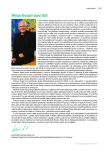Clinical contribution of new basal analogue insulin
Authors:
Alena Adamíková
Authors‘ workplace:
Diabetologické centrum Krajské nemocnice T. Bati, a. s., Zlín
Published in:
Vnitř Lék 2016; 62(7-8): 534-538
Category:
Reviews
Overview
Chronic long term hyperglycemia plays a key role in the pathogenesis of micro and macrovascular complications. The UKPDS study and its further analysis has proved that reduction of the value of glycated hemoglobin by 1 % leads to a 14 % reduction of the risk of myocardial infarction and a 37 % reduction of the risk of microvascular complications. Effective control of glycaemia, optimal value of pre-prandial, postprandial glycaemia, and low variability from the start of the disease has a long term beneficial impact. The therapy of basal insulin analogues ranks among the recommended procedures for achieving control. The new insulin analogues (insulin glargin 300 U/ml, insulin degludec) have a longer effect, practically a peakless course, lower variability, lower risk of hypoglycemia events and better application technique with greater flexibility of administration. The pharmacokinetic and pharmacodynamics properties provide new quality in the chronic therapy of people with type 1 and 2 diabetes.
Key words:
diabetes mellitus – glycemia control – hypoglycemia – new basal insulin analogues
Sources
1. Heise T, Nosek L, Dellweg S et al. Impact of injection speed and volume on perceived pain during subcutaneous injections into the abdomen and thigh: a single-centre, randomized controlled trial. Diab Obes Metab 2014; 16(10): 971–976.
2. Reutrakul S, Wroblewski K, Brown RL. Clinical use of U-500 regular insulin: review and meta-analysis. J Diabetes Sci Technol 2012; 6(2): 412–420.
3. Heise T, Hermanski L, Nosek L et al. Insulin degludec: four times lower pharmacodynamic variability than insulin glargine under steady-state conditions in type 1 diabetes. Diab Obes Metab 2012; 14(9): 859–864.
4. Landstedt-Hallin L. Changes in HbA1c, insulin dose and incidence of hypoglycemia in patients with type 1 diabetes after switching to insulin degludec in an outpatient setting: an observational study. Curr Med Res Opin 2015; 31(8): 1487–1493.
5. Ahmann A, Rodbard HW, Rosenstock J et al. Efficacy and safety of liraglutide versus placebo added to basal insulin analogues (with or without metformin) in patients with type 2 diabetes: a randomized, placebo-controlled trial. Diab Obes Metab 2015; 17(11): 1056–1064.
6. Gough SCL, Jain R, Woo VC. Insulin degludec/liraglutide (IDegLira) for the treatment of type 2 diabetes. Expert Rev Endocrinol Metab 2016; 11(1): 7–19.
7. SPC Xultophy. Dostupné z WWW: <http://www.ema.europa.eu/docs/cs_CZ/document_library/EPAR_-_Product_Information/human/002647/WC500177657.pdf>.
8. Marso SP, Poulter NR, Nissen SE et al. Design of the liraglutide effect and action in diabetes: evaluation of cardiovascular outcome results (LEADER®) trial. Am Heart J 2013; 166(5): 823–830.
9. Marso SP, Daniels GH, Brown-Frandsen K et al. Liraglutide and cardiovascular outcomes in type 2 diabetes. N Engl J Med 2016; 375(4): 311–322. Dostupné z DOI: <http://dx.doi.org/10.1056/NEJMoa1603827>.
10. Atkin S, Javed Z, Fulcher G. Insulin degludec and insulin aspart: novel insulins for the management of diabetes mellitus. Ther Adv Chronic Dis 2015; 6(6): 375–388.
11. Fulcher G, Christiansen J, Bantwal G et al. Comparison of insulin degludec/insulin aspart and biphasic insulin aspart 30 in uncontrolled, insulin-treated type 2 diabetes: a phase 3a, randomized, treat-to-target trial. Diabetes Care 2014; 37(8): 2084–2090.
12. Cooper J, Pieber T, Cariou B et al. Treatment intensification with IDegAsp BID vs IDeg OD plus IAsp in insulin-treated patients with type 2 diabetes: a randomised, controlled phase 3 trial. Diabetologia 2014; 57(Suppl 1): S69.
13. Onishi Y, Ono Y, Rabøl R et al. Superior glycaemic control with once-daily insulin degludec/insulin aspart versus insulin glargin in Japanese adults with type 2 diabetes inadequately controlled with oral drugs: a randomized, controlled phase 3 trial. Diabet Obes Metab 2013; 15(9): 826–832.
14. Becker RH, Dahmen R, Bergmann K et al. New insulin glargine 300 Units. ml-1 provides a more even activity profile and prolonged glycemic control at steady state compared with insulin glargine 100 Units. mL-1. Diabetes Care 2015; 38(4): 637–643.
15. Yki-Järvinen H, Bergenstal RM, Bolli GB et al. Glycaemic control and hypoglycaemia with new insulin glargine 300 U/ml versus insulin glargine 100 U/ml in people with type 2 diabetes using basal insulin and oral antihyperglycaemic drugs: the EDITION 2 randomized 12-month trial including 6-month extension. Diab Obes Metab 2015; 17(12):1142–1149. Dostupné z DOI: <http://dx.doi.org/10.1111/dom.12532>.
16. Home PD, Bergenstal RM, Riddle MC et al. Glycaemic control and hypoglycaemia with new insulin glargine 300U/ml in people with type 1 diabetes (EDITION 4) (Abstract 148). Diabetologia 2014; 57(Suppl 1): S69-S70. Dostupné z DOI: <http://dx.doi.org/10.1055/s-0035–1549733>.
17. Ritzel R, Vidal J, Aroda VR et al. Efficacy and safety across the final dose ranges in patients with T2DM receinving insulin glargine/lixisenatide fixed-ratio combination in the LixiLan-L trial (NCT02058160). American Diabetes Association 76th scientific sessions. New Orleans, LA, June 10–14, 2016. Diabetes 2016; 65(Suppl 1): 1024-P.
18. Henry RR, Ahrén B, Davies M et al. Consistent outcomes across dose ranges with titratable LixiLan, insulin glargine/lixisenatide fixed-ratio combination, in the LixiLan-O trial (NCT02058147). American Diabetes Association 76th scientific sessions. New Orleans, LA, June 10–14, 2016. Diabetes 2016; 65(Suppl 1): 1017-P.
Labels
Diabetology Endocrinology Internal medicineArticle was published in
Internal Medicine

2016 Issue 7-8
Most read in this issue
- Treatment of liver cirrhosis – actually possibility of ambulant internist
- Sepsis – how to recognize and what to focus on – back to basics in the light of the new definition
- The skin – a mirror of internal diseases
- Prevention and therapy of sarcopenia in the ageing
